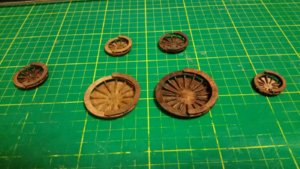-

Win a Free Custom Engraved Brass Coin!!!
As a way to introduce our brass coins to the community, we will raffle off a free coin during the month of August. Follow link ABOVE for instructions for entering.
You are using an out of date browser. It may not display this or other websites correctly.
You should upgrade or use an alternative browser.
You should upgrade or use an alternative browser.
La Couronne Corel/scratch 1:100 First build [COMPLETED BUILD]
- Thread starter DARIVS ARCHITECTVS
- Start date
- Watchers 54
Brilliant work. I love the details.
Thanks, gentlemen. If progress in ship models is the same as how I learned to fashion medieval armour from my masters, the next ship model should be even better. I can't wait to start on HMS Sovereign of the Seas! I have to learn how to rig and set sails on La Couronne first. It should be done in about one year. To shape the silkspan into full bellied sails, perhaps balloons covered with paper mache' could be used as forms instead of wood. That should be faster than carving wooden forms, and making them in into different sizes is simply a matter of how much air. 
Hi, Did you ever consider using wire hanger(cut to size) to shape the sails. Don
Hi, Did you ever consider using wire hanger(cut to size) to shape the sails. Don
Hi Don! Yes, I heard about the wire used to hold the shape, but keeping the edges of the sail in the proper position is just part of issue in keeping the sail's appearance as billowing under wind. There is a concern that the wire, no matter how small, will be difficult to hide, partly because the sail will be partially translucent. Having never built a wooden ship model before, the problem of shaping silkspan into a three dimensional shape that will hold with the help of wire is totally new to me. Lauren's videos on silkspan use in sails are excellent, but he doesn't go into detail on the shaping of billowing sails, but shows you how to make excellent furled sails and lateen or jib sails, which are not billowed out nearly as far as a typical squaresail. On the 1:100 scale of La Couronne, the seams of the sail panels should probably be simulated with simple thin pencil lines protected by a thin coat of matt lacquer. I can already see my fat fingers ripping the hell out of three hours of sail rigging work...
Last edited:
Hi everyone!
Work has been busy, but I finally got around to tackling the problem of how to make the trestle-trees and install the lower top on the main mast. After looking at the masthead piece provided by the kit, it became clear that a scratch built one would be far better, so I made one from walnut. The square hole to accept the top of the main mast was drilled halfway though, then the corners square out using a chip carving tool. You have to wear a magnifier to see parts this small. I can't wait to do the upper tops and mizzen mast top. So tiny. Two holes were drilled with an Archimedes drill for the halyards, and the channels to guide the halyards were made with a chip carving tool.
The bottom of the topmast needed to have some wood added to it to made the box shape that nests between the trestles. This feature was missing from the Corel instructions, so the last had to be built back up and reshaped. True to Dutch style, the weight of the topmast is supported by a cross member. The space between the main mast and the topmast is just wide enough for the halyards and ties for the yardarm to pass between them.
After fashioning the cheeks and the trestles and attaching them to the main mast, the slots for the cross-trees were carefully cut with the band saw, and glued into place. The trestle-tree dimensions were measured, and the hole cut and filed into the top to match. The lengths of the trestles and cross-trees were adjusted with the ends being trimmed and reshaped. Getting the top to fit in the proper position took a lot of futzing in order to get the hole dimensions just right. The inboard ends of all the rail supports has to be reshaped. Trim was added around the hole in the top. Using a pin with the point filed off, black enamel model paint was used to make the iron rivet heads on the top trim, trestles and cheeks. The masthead and top are not glued to the mast assembly yet. This will allow easy access to the underside of the top for installation of blocks, and other work on the masts. The whole process was made easier using EJ's build log for La Couronne.
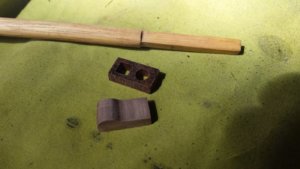
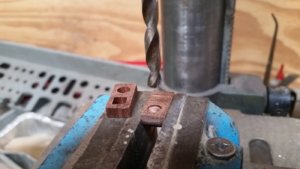
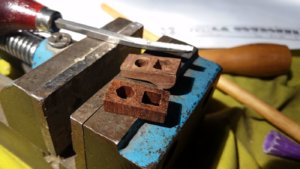
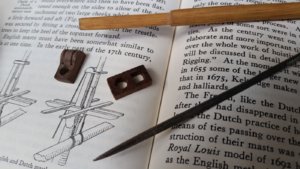
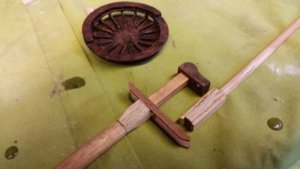
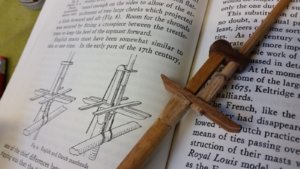

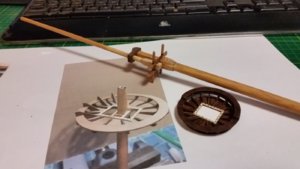
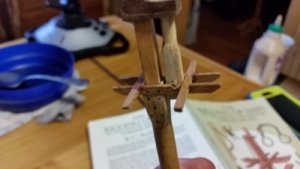
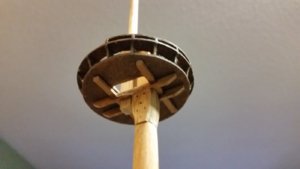
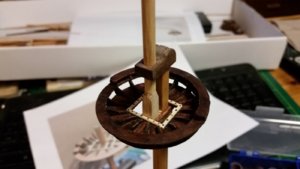
Work has been busy, but I finally got around to tackling the problem of how to make the trestle-trees and install the lower top on the main mast. After looking at the masthead piece provided by the kit, it became clear that a scratch built one would be far better, so I made one from walnut. The square hole to accept the top of the main mast was drilled halfway though, then the corners square out using a chip carving tool. You have to wear a magnifier to see parts this small. I can't wait to do the upper tops and mizzen mast top. So tiny. Two holes were drilled with an Archimedes drill for the halyards, and the channels to guide the halyards were made with a chip carving tool.
The bottom of the topmast needed to have some wood added to it to made the box shape that nests between the trestles. This feature was missing from the Corel instructions, so the last had to be built back up and reshaped. True to Dutch style, the weight of the topmast is supported by a cross member. The space between the main mast and the topmast is just wide enough for the halyards and ties for the yardarm to pass between them.
After fashioning the cheeks and the trestles and attaching them to the main mast, the slots for the cross-trees were carefully cut with the band saw, and glued into place. The trestle-tree dimensions were measured, and the hole cut and filed into the top to match. The lengths of the trestles and cross-trees were adjusted with the ends being trimmed and reshaped. Getting the top to fit in the proper position took a lot of futzing in order to get the hole dimensions just right. The inboard ends of all the rail supports has to be reshaped. Trim was added around the hole in the top. Using a pin with the point filed off, black enamel model paint was used to make the iron rivet heads on the top trim, trestles and cheeks. The masthead and top are not glued to the mast assembly yet. This will allow easy access to the underside of the top for installation of blocks, and other work on the masts. The whole process was made easier using EJ's build log for La Couronne.











Last edited:
- Joined
- Aug 16, 2019
- Messages
- 870
- Points
- 343

Ok let me tell you a small story
Build model since the age of 6 now 67
In Montreal there are a hobby store that use to have in the front a Courone
For many, many year I was admiring that model
After I succeed to build my first wood ship 27y ago I decide to get that ship that made me dream all those year I have her still in her box and waiting the time where my skill improve enough to build here properly.
All the modification you did to that kit make me wonder if I will ever have the talent to come close to what you are doing.
Beautiful build
Build model since the age of 6 now 67
In Montreal there are a hobby store that use to have in the front a Courone
For many, many year I was admiring that model
After I succeed to build my first wood ship 27y ago I decide to get that ship that made me dream all those year I have her still in her box and waiting the time where my skill improve enough to build here properly.
All the modification you did to that kit make me wonder if I will ever have the talent to come close to what you are doing.
Beautiful build
Ok let me tell you a small story
Build model since the age of 6 now 67
In Montreal there are a hobby store that use to have in the front a Courone
For many, many year I was admiring that model
After I succeed to build my first wood ship 27y ago I decide to get that ship that made me dream all those year I have her still in her box and waiting the time where my skill improve enough to build here properly.
All the modification you did to that kit make me wonder if I will ever have the talent to come close to what you are doing.
Beautiful build
It is my new mission in life to inspire you to begin AND FINISH your model of La Couronne. I do have lots of experience making other things, but what you can see from my build is that the steps to make and fit the parts are actually using very simple techniques and tools. The secret is liking it enough that you spend 4 hours like I did yesterday measuring and fashioning the parts with the tools you have without remembering that you haven't eaten in 10 hours, or that you have any other stuff to do. It's rushing the project and being in too much of a hurry that makes the model less well finished and not as well in appearance. Treat each small piece as a model kit unto itself.
Example: I came very close to screwing up the hole cutting in the top by using a drill press with a 3/8" diameter drill bit to make the first hole while holding the top by the rails. It seemed the fastest way of removing a lot of wood so I could jump right to the final shaping of the hole with sanding sticks or jewelers files. If I didn't let go of it PRECISELY when the drill bit grabbed the top and spun it, I would have crunched 6 hours of work into a pile of tiny worthless pieces. I made judgement errors like that all the time, even after decades of hand tool experience. You will too. I took the top off the drill press and used hand tools to remove the wood from that delicate part.
The difference is, will you be willing to take those risks and build, and by making mistakes, learn valuable though time consuming lessons and eventually have a wonderful ship model, or let the model sit in a box on the shelf? You don't take out the enemy machine gun nest without throwing yourself onto the barbed wire. With help from others like the builders on this forum, you can learn shortcuts and tips the help avoid the big mistakes. The little ones will always plague you. I spend 95% of my time thinking about the next move, and only 10% actually cutting, filing, and fitting the parts.
BUT, if you don't make a first model that you deem is 70% as good as most others (a reasonable first start), then your won't start and build the next one, which WILL be a vast improvement, more than you would guess. If you have steady hands and love this hobby, you can potentially rival anyone's models in about 3-4 builds, provided you keep the passion and innovation at a high level all the way through.
One big thing I fear is working the model into a corner such that some of the features I wanted to add detail to are no longer accessible because new parts are in the way. Rigging is all about that, having to decide what blocks to fit to the masts and yards before you set them into place and and start work on the shrouds. I am at that stage now, and have zero experience. Talk about worrying. Eventually, after looking at the big picture and a bunch of other's build logs, a plan of several steps will form. It always does. You can't let fear of mistakes STOP you. Virtually any screw-up CAN be repaired, although it sucks to have to rebuild large portions of a project. It can still be done.
Here's a good thing. I told this to all the medieval armour apprentices I taught while we worked for days over the anvil. When you build something and it's finally finished, you AND ONLY YOU will see all the misalignments, minor flaws, disguised mistakes, and shortcuts taken. Others will only see a wondrous piece of craftsmanship... and they will say so. When they compliment your work, don't make the mistake of pointing out all the flaws. Just say "Thank you" and move on to your next piece. You will ALWAYS be 10 times more critical of your work than anyone else. Only others experienced in the art will be able to see the flaws. Those are the persons you seek out to get direction on where to improve.
There are limitations we place on ourselves to consider. For example, I am choosing not to devote the time into learning how to sculpt all the pieces that make up the decorations as on Doris Obručová's incredible scratch built HMS Sovereign of the Seas. I have already decided that that level of detail is beyond my desire to spend time developing, but will use metal castings and other means to get as close to that ship model as I can and be satisfied with that level of detail. It would be nice to get that ship finished BEFORE I die.
Despite all the changes that have been made to the kit I'm working on, the ship is far ahead of the 3-4 year estimate that was made in the beginning, even with a five-year-old boy to chase around and a full time job and family to provide for. So far things are working out well.
Last edited:
- Joined
- Aug 16, 2019
- Messages
- 870
- Points
- 343

Tank you very munch for you encouragement
I will build the Courone but I have still a few kits to make before.
And learning new skill
One thing that I have learn over the year is knowing my limitation
I know at what level I am, and know that I have to improve and each kit I do is a bit better of the precedent so there are hope
I will build the Courone but I have still a few kits to make before.
And learning new skill
One thing that I have learn over the year is knowing my limitation
I know at what level I am, and know that I have to improve and each kit I do is a bit better of the precedent so there are hope
Tank you very munch for you encouragement
I will build the Courone but I have still a few kits to make before.
And learning new skill
One thing that I have learn over the year is knowing my limitation
I know at what level I am, and know that I have to improve and each kit I do is a bit better of the precedent so there are hope
I just saw your Hemione.... VERY NICE!
One short statement to your words:Ok let me tell you a small story
Build model since the age of 6 now 67
In Montreal there are a hobby store that use to have in the front a Courone
For many, many year I was admiring that model
After I succeed to build my first wood ship 27y ago I decide to get that ship that made me dream all those year I have her still in her box and waiting the time where my skill improve enough to build here properly.
All the modification you did to that kit make me wonder if I will ever have the talent to come close to what you are doing.
Beautiful build
Once, in near future or far away (and nobody can tell you), you will be not able to built her, or complete her.
Your model deserves it to be built by you and nobody else - so start her as the next project - and I am very sure, that she will be a very good model

Work was started on the fore mast today. The masthead was cut from walnut using a band saw. A drill press was used to drill the lower mast hole partially through, and the topmast hole all the way through the masthead. To get a good fit to the topmast, the hole was carefully filed to final fit. The mast hole required being cut to square, and this was done with a ship carving tool to make the corners, and a small flathead screwdriver was sharpened into a tiny wood chisel and used to shave out the wood to final shape. The fore mast was test fit into the hole. If it is too tight, you risk splitting the masthead.
The bottom end of the topmast needed wood added to make the box end that fits between the trestle-trees later on (thanks, Corel, for not putting this into the blueprints!). Instead of adding four thin pieces on the sides like I did with the main mast, I drilled and filed a hole into piece of scrap aspen wood, and used the bands saw to reduce it close to its final size, then glued in onto the bottom end of the topmast. Then the end was filed and carefully sanded until the flats were nearly sanded through to the mast inside. A small hand sanding block was used to carefully shape the end until it appeared to be part of the original mast piece. Some pine stain made the white aspen piece blend in well with the birch mast.
The cheeks were cut from a thin strip of red oak, which is what I had on hand. It adds a course grain which contrasts the fine grain of the mast. Like the cheeks on the main mast, the pieces were cut and glued to the mast, and shaped carefully using a belt sander, then hand sanded to finished dimensions.
The trestle-trees were cut from mahogany and were slightly less in length that the ones on the main mast. They ends were shaped with a sanding block, then glued to the mast, on top of the cheeks. The center point of each trestle-tree is line up at the spot directly between the lower mast and the topmast when they are fitted together using the masthead. That way, you know exactly where the center of the top will be later on. The bottom end of the topmast fits nicely between the trestle-trees with no play, and not too tightly. To mark on the trestle-trees where the notches that accept cross-trees will go, assemble the lower mast, topmast, and masthead. Make sure that lower mast and topmast are parallel to each other, then mark the notch locations with a pencil, such that the front cross-tree lays across the front surface of the topmast, and the rear cross-tree lays across the rear surface of the cheek plate that is on the rear side of the lower mast. Cut the notches carefully with the band saw or file them out. Glue the cross-trees to the trestle-trees.
The hole in the center of the top is roughly cut with a drill press, then hand filed a rectangular shape. the fore-aft dimension of the hole is equal to the space between the cross tress, and the width of the hole is about 30% wider to make room for the shrouds. Check the lengths of the trestle-trees and cross-trees using the top, with mast assembly put together, and check the fit of all parts. They should fit together well with no play if you sanded everything to the right dimensions. Lastly, cut a notch in the top edges of the trestle-trees to accept the cross lug which supports the weight of the topmast. Make the notch locations on the topmast, drill a hole for the cross lug, and make the cross lug from a stick of walnut wood. Glue the cross lug into the bottom end of the topmast. The ends of the lug should sit perfectly in the notches of the trestle-tree, anchoring the bottom of the topmast into position. Do not glue the topmast and masthead into position. You will need to disassemble the topmast for access as you begin rigging the shrouds for the lower mast.
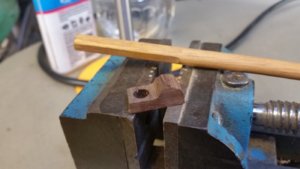
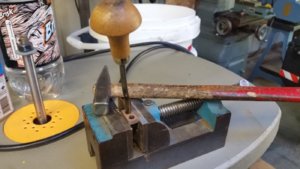
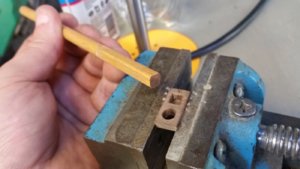
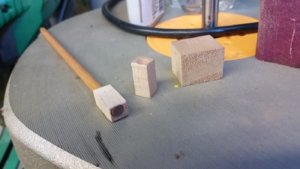
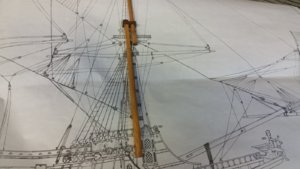
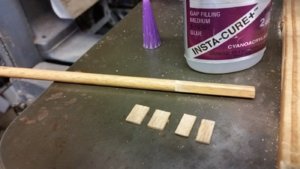
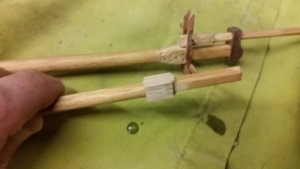
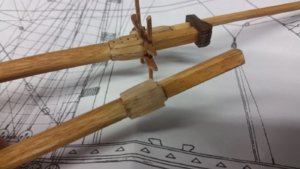
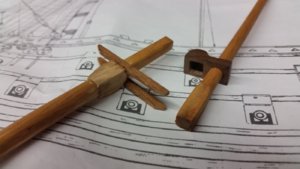
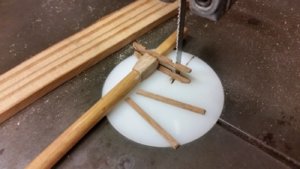
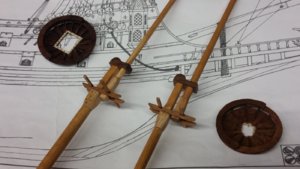
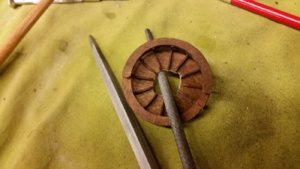
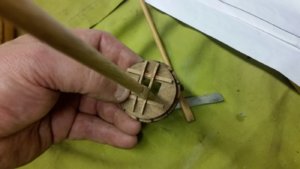

The bottom end of the topmast needed wood added to make the box end that fits between the trestle-trees later on (thanks, Corel, for not putting this into the blueprints!). Instead of adding four thin pieces on the sides like I did with the main mast, I drilled and filed a hole into piece of scrap aspen wood, and used the bands saw to reduce it close to its final size, then glued in onto the bottom end of the topmast. Then the end was filed and carefully sanded until the flats were nearly sanded through to the mast inside. A small hand sanding block was used to carefully shape the end until it appeared to be part of the original mast piece. Some pine stain made the white aspen piece blend in well with the birch mast.
The cheeks were cut from a thin strip of red oak, which is what I had on hand. It adds a course grain which contrasts the fine grain of the mast. Like the cheeks on the main mast, the pieces were cut and glued to the mast, and shaped carefully using a belt sander, then hand sanded to finished dimensions.
The trestle-trees were cut from mahogany and were slightly less in length that the ones on the main mast. They ends were shaped with a sanding block, then glued to the mast, on top of the cheeks. The center point of each trestle-tree is line up at the spot directly between the lower mast and the topmast when they are fitted together using the masthead. That way, you know exactly where the center of the top will be later on. The bottom end of the topmast fits nicely between the trestle-trees with no play, and not too tightly. To mark on the trestle-trees where the notches that accept cross-trees will go, assemble the lower mast, topmast, and masthead. Make sure that lower mast and topmast are parallel to each other, then mark the notch locations with a pencil, such that the front cross-tree lays across the front surface of the topmast, and the rear cross-tree lays across the rear surface of the cheek plate that is on the rear side of the lower mast. Cut the notches carefully with the band saw or file them out. Glue the cross-trees to the trestle-trees.
The hole in the center of the top is roughly cut with a drill press, then hand filed a rectangular shape. the fore-aft dimension of the hole is equal to the space between the cross tress, and the width of the hole is about 30% wider to make room for the shrouds. Check the lengths of the trestle-trees and cross-trees using the top, with mast assembly put together, and check the fit of all parts. They should fit together well with no play if you sanded everything to the right dimensions. Lastly, cut a notch in the top edges of the trestle-trees to accept the cross lug which supports the weight of the topmast. Make the notch locations on the topmast, drill a hole for the cross lug, and make the cross lug from a stick of walnut wood. Glue the cross lug into the bottom end of the topmast. The ends of the lug should sit perfectly in the notches of the trestle-tree, anchoring the bottom of the topmast into position. Do not glue the topmast and masthead into position. You will need to disassemble the topmast for access as you begin rigging the shrouds for the lower mast.














More mast work. The work on the fore mast masthead, top, and iron nail details was done on the foremast today. The masthead halyard channels were filed with a lozenge shaped needle file, then the holes for the halyards were drilled through with an Archimedes drill. The trim was added around the hole in the top with thin basswood strip and some CA glue. The shank of a brass pin mounted in a stick makes a great nail head painter.
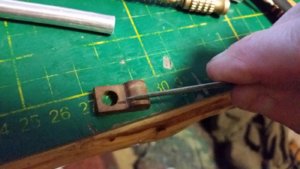
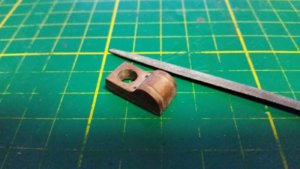
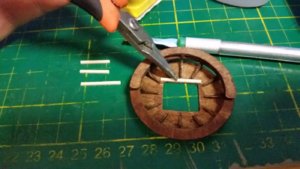
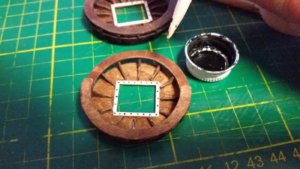
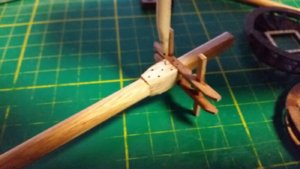
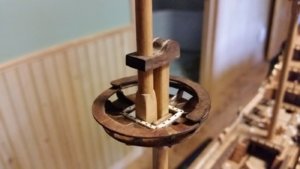
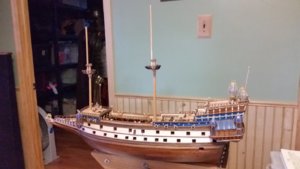







Steady and most important - excellent progress! Great accomplishment thus far.
I spent the whole day making masts, trestles, and caps. All the tops and trestle-trees aren't make yet, but a lot of pieces got done.
The first thing was making the top-gallant masts and flag-staves for the mainmast and foremast. The kit blueprints show the top-gallant mast and flagstaff for each mast as a single mast. Ej's La Couronne build log showed that he changed these also. So, after cutting the pieces according to the instructions, I had to make two top-gallant masts and cut the flag-staves, and create one more cap for each. It still have yet to remake the mizzen topmast into two sections, one for the topmast and one for the flagstaff. The new top-gallant mast pieces still need to be stained to a golden color to match the lower mast parts.
Caps for each mast section were made by using cutting a rectangular rod of walnut to a width proportional to the size of the mast below it. Then the two holes were drilled into the bottom side of the wood, partially through for the top of the mast below, and all the way through for the upper mast. A band saw was used to cut the size profile of each cap. The rear hole is squared out using a tiny sharpened flat screwdriver as a wood chisel, with the cap being held in a small machinist vise. Two tiny holes are drilled and two grooves are filed for the ties, which are lines that pass over the caps and down to the yardarms, and hold the yardarms up. The sizes of the caps got proportionally smaller as you go up, and the kit blueprints provide a good guide as to the sizes you need to make. When fitting the upper mast through the hole in the cap, make sure you drilled the hole smaller than the mast, and file it out to fit the mast without being too loosed or too tight to assemble the parts.
The knee for the bowsprit topmast was rough cut from walnut using the band saw. The angle of the knee was approximated from the blueprints. The resulting angle should have the bowsprit topmast angled slightly forward, because the tension of the rigging will pull it back to vertical later on. I've seen others forget about this and end up with a topmast leaning back at a crazy angle because the rigging pulled it out of position. A cap was fashioned to fit the knee and the topmast. The knee was glued to the bowsprit, but the cap and topmast are left loose to allow fitting of the top later.
The cheeks that support the bottom trestle-tree for the mizzenmast were glue to the sides of the mast, then filed and sanded to shape. A cap was fashioned, and the topmast was fitted. The center hole in the mizzen top was cut after measuring the distance between the cross-trees. This provide the width of the hole in fore-aft direction. The hole was made about 30% wider side-to-side to make room for the shrouds to pass through the top. This is the tiniest top on the model, so the trestle-tree parts are not much more than toothpick size. The foot of the topmast has a cross-peg through it which rests in notches cut on top of the trestles, which takes the weight of the topmast. A sliver of walnut was used as the cross-peg, just like on the foremast and mainmast. I'll get around to making a separate topmast and flagstaff for the mizzen later.
I ran out of daylight, and I still haven't eaten since breakfast, so work is done for the time being. All the mast parts were fitted to the ship, held by friction and gravity, just to get a view of the progress. The top of the mainmast looks bent, but it's just sitting loose without trestle-trees to support it yet. I'm amazed how thin and tiny these parts are. Time to eat!
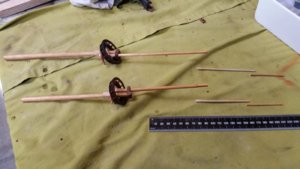
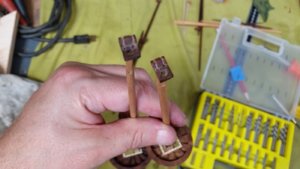
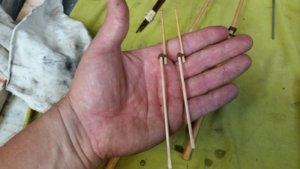
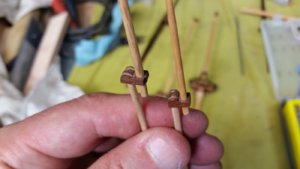
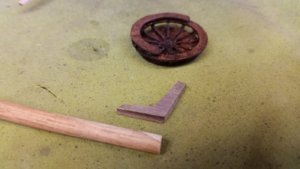
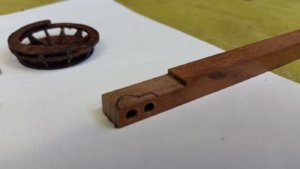
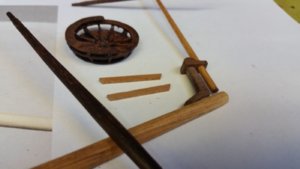
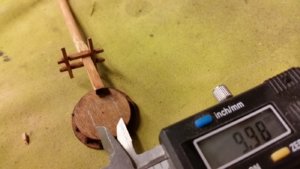
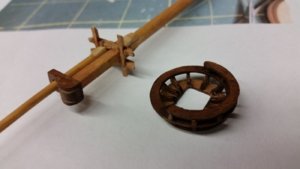
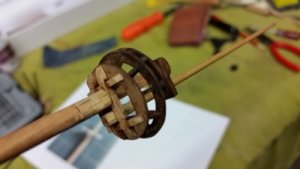
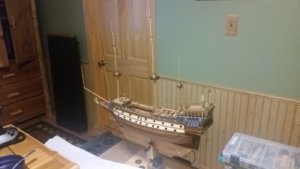
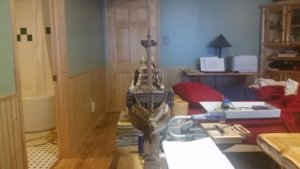
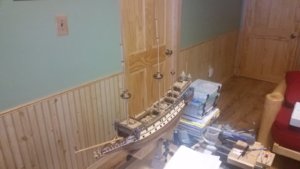
The first thing was making the top-gallant masts and flag-staves for the mainmast and foremast. The kit blueprints show the top-gallant mast and flagstaff for each mast as a single mast. Ej's La Couronne build log showed that he changed these also. So, after cutting the pieces according to the instructions, I had to make two top-gallant masts and cut the flag-staves, and create one more cap for each. It still have yet to remake the mizzen topmast into two sections, one for the topmast and one for the flagstaff. The new top-gallant mast pieces still need to be stained to a golden color to match the lower mast parts.
Caps for each mast section were made by using cutting a rectangular rod of walnut to a width proportional to the size of the mast below it. Then the two holes were drilled into the bottom side of the wood, partially through for the top of the mast below, and all the way through for the upper mast. A band saw was used to cut the size profile of each cap. The rear hole is squared out using a tiny sharpened flat screwdriver as a wood chisel, with the cap being held in a small machinist vise. Two tiny holes are drilled and two grooves are filed for the ties, which are lines that pass over the caps and down to the yardarms, and hold the yardarms up. The sizes of the caps got proportionally smaller as you go up, and the kit blueprints provide a good guide as to the sizes you need to make. When fitting the upper mast through the hole in the cap, make sure you drilled the hole smaller than the mast, and file it out to fit the mast without being too loosed or too tight to assemble the parts.
The knee for the bowsprit topmast was rough cut from walnut using the band saw. The angle of the knee was approximated from the blueprints. The resulting angle should have the bowsprit topmast angled slightly forward, because the tension of the rigging will pull it back to vertical later on. I've seen others forget about this and end up with a topmast leaning back at a crazy angle because the rigging pulled it out of position. A cap was fashioned to fit the knee and the topmast. The knee was glued to the bowsprit, but the cap and topmast are left loose to allow fitting of the top later.
The cheeks that support the bottom trestle-tree for the mizzenmast were glue to the sides of the mast, then filed and sanded to shape. A cap was fashioned, and the topmast was fitted. The center hole in the mizzen top was cut after measuring the distance between the cross-trees. This provide the width of the hole in fore-aft direction. The hole was made about 30% wider side-to-side to make room for the shrouds to pass through the top. This is the tiniest top on the model, so the trestle-tree parts are not much more than toothpick size. The foot of the topmast has a cross-peg through it which rests in notches cut on top of the trestles, which takes the weight of the topmast. A sliver of walnut was used as the cross-peg, just like on the foremast and mainmast. I'll get around to making a separate topmast and flagstaff for the mizzen later.
I ran out of daylight, and I still haven't eaten since breakfast, so work is done for the time being. All the mast parts were fitted to the ship, held by friction and gravity, just to get a view of the progress. The top of the mainmast looks bent, but it's just sitting loose without trestle-trees to support it yet. I'm amazed how thin and tiny these parts are. Time to eat!













Last edited:
In case anyone wants to see ALL the pictures in order from this thread, here they are on my ImgBB page:
La Couronne Build Image Library
La Couronne Build Image Library
- Joined
- Aug 16, 2019
- Messages
- 870
- Points
- 343

Detail, detail, detain=l
I am always amaze of the talent of some
A joy to follow
I am always amaze of the talent of some
A joy to follow
I had to change the last post. I was using the term masthead when I really meant cap. 
I also just read in H. Anderson that the topgallant caps were did not have the ties that lift the topgallant and flagstaff masts run over the tops of the caps. So, I will remove the topgallant and flagstaff caps and remake them without the holes and grooves for the ties, then try to figure out how the ties were rigged for those upper mast staves. Every time I refer to the book, I learn something new.
I also just read in H. Anderson that the topgallant caps were did not have the ties that lift the topgallant and flagstaff masts run over the tops of the caps. So, I will remove the topgallant and flagstaff caps and remake them without the holes and grooves for the ties, then try to figure out how the ties were rigged for those upper mast staves. Every time I refer to the book, I learn something new.
This is the oldest way to learn, and still the best one (IMHO)!Every time I refer to the book, I learn something new.


